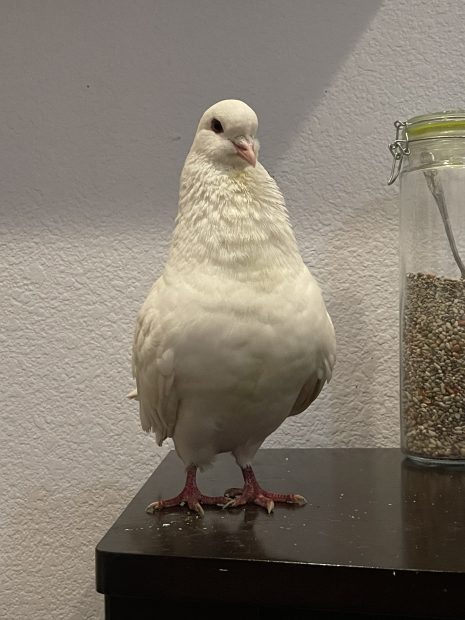
Mochi
Guest Post by Nicole Smith
Big king man Mochi self-rescued in my in-laws’ backyard. They found him hanging out with the songbirds, eating corn off the ground. Chris and I took him in, and he soon became a permanent family member. Less than a couple months later, lovely king squeaker hen Fuji self-rescued very assertively by landing on my horse while I was giving him a rinse. She came home and became pigeon family member number two. Eventually the two of them married. Mochi maintained his comfortable but suspicious attitude toward Chris and me, while Fuji grew into a confident bi-cultural citizen.
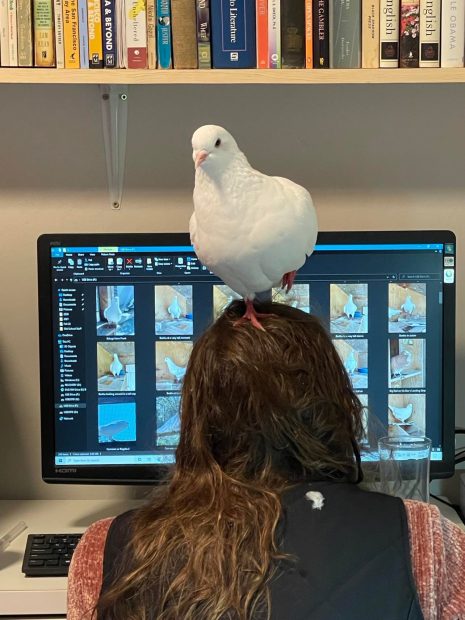
Fuji & I
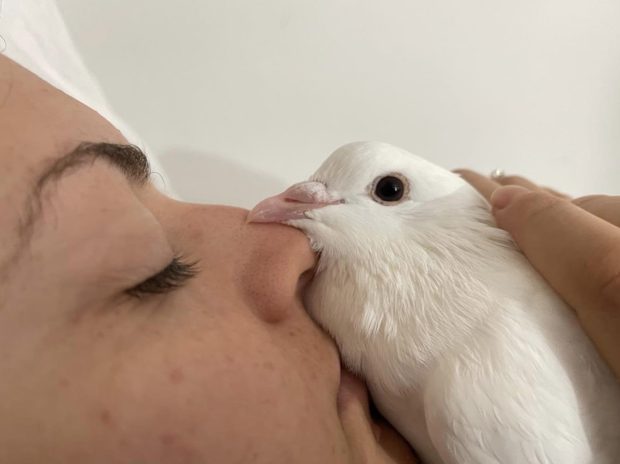
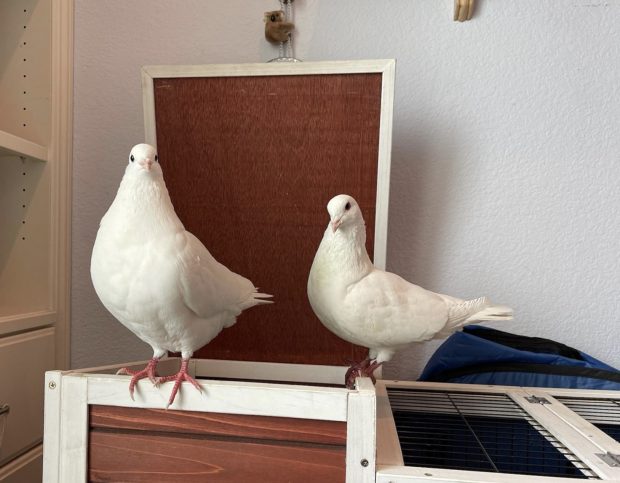
Fuji & Mochi
A few new rescue pigeons and almost a year later, I posted the following on the Palomacy facebook help group:
Is it ever a good idea to split up a mated pair? My two beat each other up pretty dramatically today. (Editor’s note: While it can be very upsetting, the nicks shown on their ceres in the photos below are extremely minor. Fights can be much worse with scary looking injuries to the face, eyes and cere. These injuries are self-resolving- very quickly- and no cleaning nor antiseptic treatment is required.)
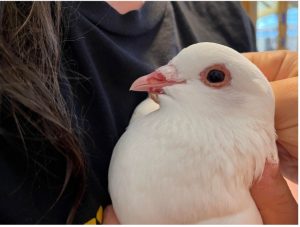
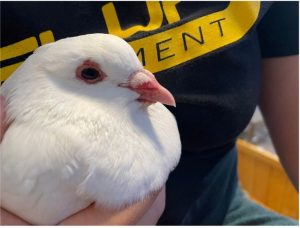
Here is the history: When they first started laying, they fought over the nest a lot and it was pretty ugly. The vet at the time advised me to remove the feggs early to keep the peace. After a while they seemed to calm down about it, but they would still have occasional scuffles (sometimes over the nest, sometimes not). They have been on a normal laying schedule for a while now and keep the feggs until they abandon them. They were scuffling this morning and I didn’t worry about it because I’m used to seeing it every once in a while. When I came home today, I found both birds pretty beat up. What would you guys do for this pair?
Other info: The male had a blood test to confirm sex. The female lays eggs. They have a very large cage (I have to get in it to clean it) and daily out of cage time.
Palomacy founder Elizabeth commented on my post with information about “UMPS” or Underemployed Male Pigeon Syndrome. When I told her I thought it might be my female that needed the extra attention, she encouraged me to trust what the birds are telling me. So I did!
A little over half a year later, I saw another person in the help group describing a similar situation with their pigeon pair and got to leave the following update:
I have a pair that sounds similar. They were fantastically sweet to each other for many months and then started fighting under similar circumstances. Hen would be on the feggs, male would come into view, and she’d run out and attack him pretty brutally. When this happens, they both get their ceres beat up and I have had to temporarily separate them because it’s too nasty for comfort. Separating them really stresses them out so I had to find a better solution. Elizabeth advised me on UMPS (UFPS in my case) and how to address it and now we have peace. She is one of my birds that is most bonded to me and one of my most curious, observant birds. If I don’t spend enough time with her, she will pick fights with her husbird over the feggs. She hates my hands and usually doesn’t want to be pet but loves sitting with me and I didn’t realize before how important this time is to her. I’ve learned that she is very clear and communicative about her needs and as long as I’m meeting them, there is total peace between her and her husbird. I got a little cat backpack for her, and she comes on trips and walks with me as part of her time with me and extra stimulation. Between the occasional cat backpack walk and making sure to spend time with her when she flies over towards me or is staring at me like this:
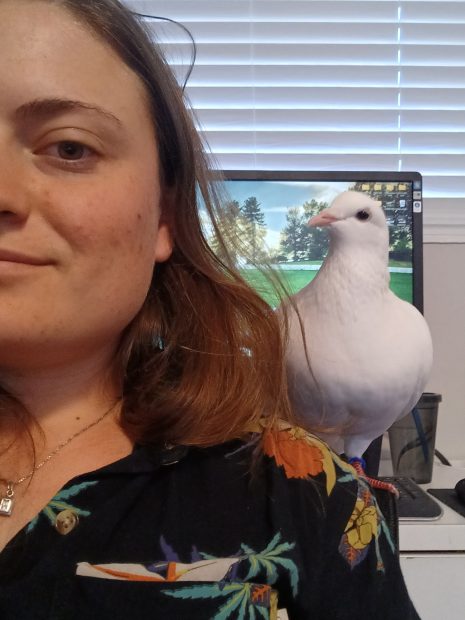
The problem has been resolved.
I also have one male that is a jerk to everyone if he doesn’t have enough playtime. He catches balled up socks and throws them around, is well entertained by hard-to-get nesting material, loves online shopping for red things, and is ALL about a good cat backpack walk. He is still a destructo-boy even with lots of play and stimulation, but I think the other birds enjoy when he’s spending most of his time beating up inanimate objects.
Listening to my birds how Elizabeth suggested has led to all kinds of positive changes that I would never have expected. I have learned not to underestimate their intelligence and emotional needs. No two birds are the same, and Fuji consistently blows me away with her ability to challenge my understanding of pigeons every day. When we are out on our walks and are passed by a stranger, she flies at them feet first with big wing flaps (in her backpack). Until my sister came with me on a walk, I figured she was getting startled and flying in the opposite direction. I never would have guessed she was darting bravely and fiercely toward the passing stranger. In our home, she is known to swoop at people other than me. After far too much time passing off her behavior as who-knows-what-she’s-doing, I have finally accepted that I have a guard pigeon.
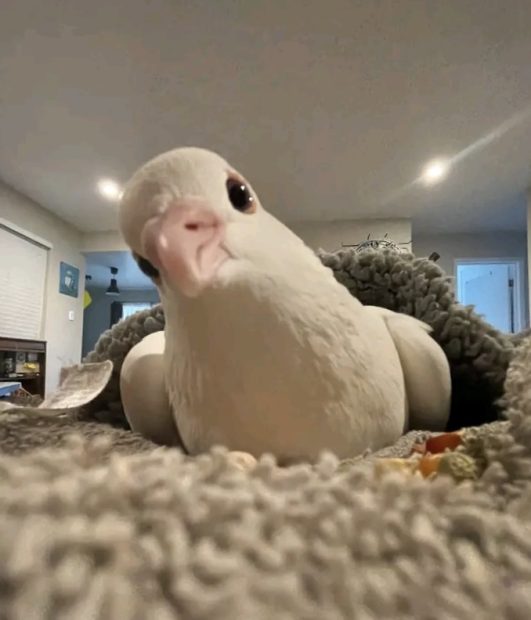
I feel honored to have this bond with her and have come to realize that our bond is as important to her as it is to me. As much as it is important not to humanize our feather friends, it’s also important not to underestimate their capacity to need friendship, play, and love in ways that seem unexpected or even impossible. Fuji is a very clear communicator, but it took me an embarrassingly long time to realize.
UMPS has now been officially renamed “UPS” to include birds like my Fuji.
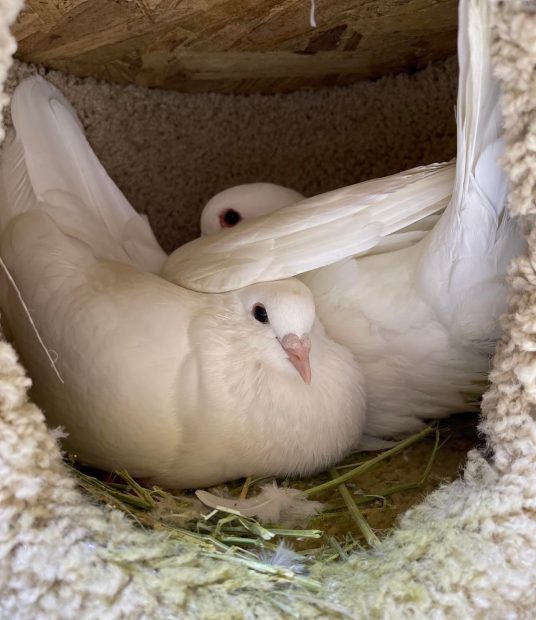
Here are some of Palomacy’s tips for the Underemployed Pigeon:
Palomacy is frequently contacted for pigeon marriage counseling assistance. One bird becomes very aggressive with another. This is something we see once in awhile. We call it Underemployed Pigeon Syndrome (UPS). Pigeons are flock birds and they have a lot of social energy, especially the males. In a flock, even though married pigeons are very devoted to one another, the males flirt with all the females and show off to, trash talk and challenge all the males. They are busy most of the day. Feral city pigeons have even more to do looking for food all day. But a lone male pigeon living as a companion in a home, either with his mate or just his people, will often get bored, frustrated and angry. It happens all the time! Fortunately there are ways to help.
We have seen great success breaking a bullying habit with time-outs though it can take many repetitions. (We sometimes use it to stop a persistent bully in an aviary too.) Implement this approach when you have the time to observe and interrupt the bullying consistently. When the aggressor attacks, say, [Name], NO and scoop them up and into a waiting pet carrier or crate. Leave them in for five minutes to start and then let them out. Watch and repeat. You can extend the timeouts to 30 minutes or even a couple of hours if needed. It will likely feel like it’s not working but stay with it and it nearly always does. (The longest I’ve had to keep this up for is a week.) Ultimately the aggressor makes the decision to stop attacking and, once they do, we’ve found that it holds. We have former bullies living peacefully beside their prior target safely. (I recognize that this is not a positive reinforcement training approach and welcome input on the subject. These next tips are positive.)
Giving the birds more enrichment is important. There are lots of good ideas out there for foraging (mostly designed for parrots but some will work or can be modified for pigeons). One approach we often recommend is using a big fake turf mat or a snuffle mat dog feeder as your pigeons’ food dish so that they have to forage for every piece. Be sure that you only use the old fashioned rubber fake turf (not the fancy looks & feels like grass cellophane kind) so that your birds don’t forage and ingest and become impacted with the fake grass. Use the same caution with snuffle mats or any fabric- no long fibered material as it can be preened and ingested and cause severe problems. Use only short fiber fabrics, think velvet or velour.
We highly recommend taking your pigeons for safe outings and it is especially valuable for underemployed pigeons! Even though they may only be riding in a pet carrier on an errand or in a stroller or bird back pack and not physically active, it really wears them out- mentally and emotionally – and gives the mate a break while they are away, too. Please always keep your pet pigeon safely secured. Riding on your shoulder or otherwise unenclosed is super dangerous for them.
Play fighting is wonderful for your underemployed pigeon! And it won’t make them more aggressive but rather the opposite. They need to burn that energy and play-fighting them with a puppet or sock on your hand or plush toy is great for them. (Short fibers only!) We also recommend creating a punching bag toy for your underemployed pigeon by hanging a plush toy where they can play fight anytime. (Use only a single strand of ribbon or string to hang it- NO LOOPS! Any loops in your pigeons’ area are a stranglulation risk.)
Male pigeons especially enjoy being able to show off in nice big mirrors and can burn off a lot of excess energy cooing and dancing at themselves. Move mirrors around so that he gets the fun of looking for and discovering them. While mirrors may or may not be good for some birds, they are great for pigeons (and they have been proven to self-recognize). Pigeons also appreciate watching videos, television (Sponge Bob is one of our adopted pigeon’s favorite), interacting via FaceTime or with two way pet cameras or monitors (especially helpful for when you’re away). If yours isn’t much impressed, try another channel or approach.
Palomacy also suggests putting out a variety of different types of nesting materials if you can (long pine needles, long grass, thin twigs, zip ties in different colors, paper shreds, etc. etc.) because they all seem to have their preferences and it’s fun to see them express theirs. In addition to different materials, you can also use different lengths with some being too short and others too long to give them the satisfaction of finding just the right stuff. Make them work for it. Put the nesting materials as far away from the nest as possible so that they spend lots of energy looking for and trundling it back to the nest. And don’t limit how much you put out. Some pigeons are very industrious and will build huge nests given the materials.
While many pigeons are very content to be masters of the leisure arts, some need to be busy to be happy. Listen to your birds. You’ll know the difference when you find what they need.
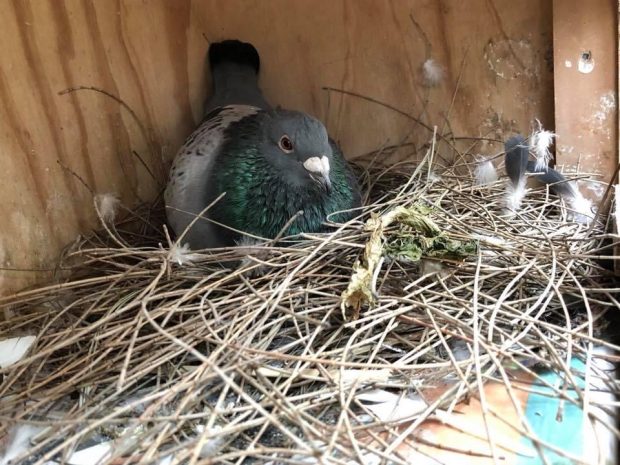
Amelio’s big nest

